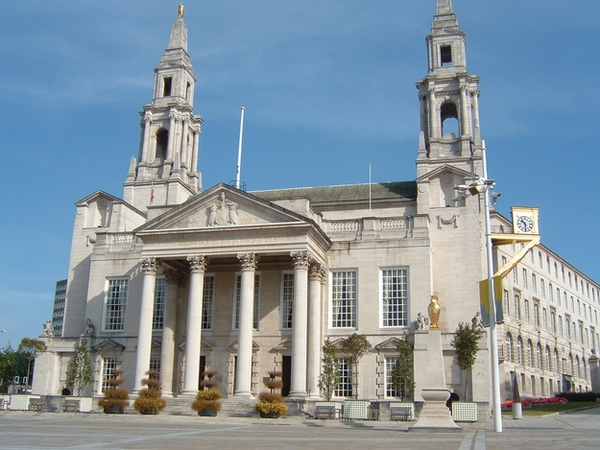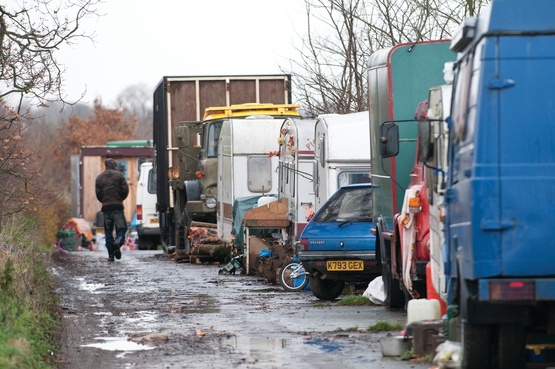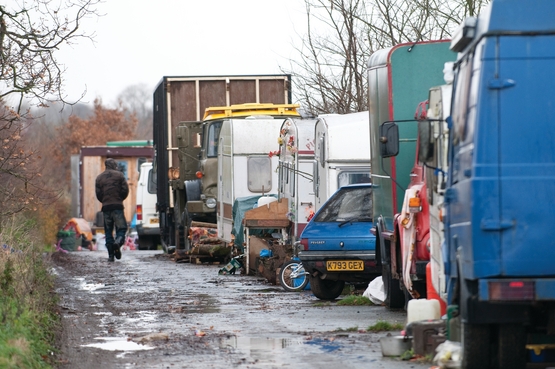You are viewing 1 of your 1 free articles
Beasts of burden
Bradford council has taken a firm stance on Gypsy and Traveller residents’ horses at Holme Wood estate. Paul Hebden pays them a visit
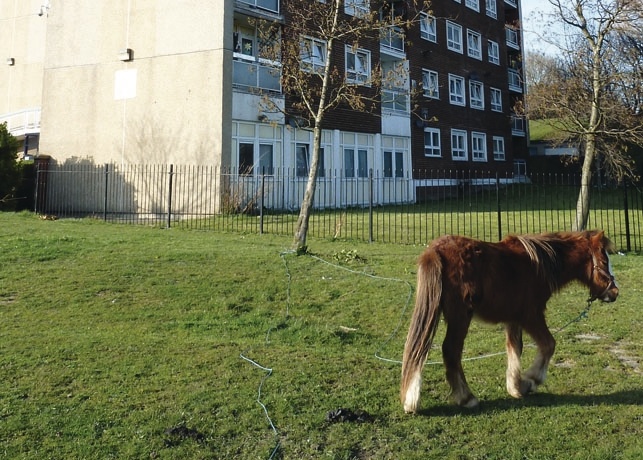
Source: James Bell
No horses are grazing on Lowther’s Field. The tethers by the Holmewood Bound pub hang loose and horseless.
Although one might not normally expect to encounter Black Beauty on a visit to a housing estate, today is different.
The Holme Wood estate is in Bradford, where about 10,000 people live side by side with equine neighbours. For decades, Holme Wood has been synonymous with horses.
Even today their presence is obvious. In what could be a scene from another century, a horse stands near playing fields and another pulls a cart along Broadstone Road, the estate’s main thoroughfare, which was once barricaded by locals to stop lorries using it as a rat run.
Elsewhere, a horse is tethered on a small strip of land in between houses, another is tied up near an old church.
Outside an off-licence two stand patiently, waiting for their owner, who emerges and guides them off.
Horse’s tale
There is a tale that is part of Bradford’s folklore. The story goes that a police officer arrived at a house one day and found a family sharing its living room with a horse.
It is a story I have heard separately from a police officer, a local resident and a housing officer. However, none of them witnessed the event, so the story may be apocryphal.
‘Why would you keep a horse in a house?’ I ask my guide, a tenant of a nearby estate with links to the Traveller and Gypsy communities.
‘I don’t know,’ says my guide. ‘Maybe it was in a stable that became an extension of the house.’
The reasons for the prevalence of the equine inhabitants become apparent down the road from the estate, in the East Bowling Cemetery.
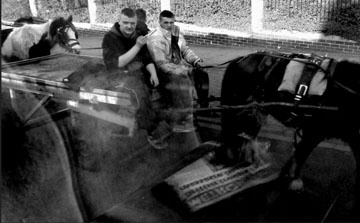
Mane road: Gypsy and Traveller communities have a tradition of keeping horses for activities such as scrapping
Many of the people buried there were part of the estate’s settled Traveller and Gypsy communities.
The Gypsy graves are impeccably well kept and grander than the others.
They are also easy to spot because they often have headstones engraved with ‘vardos’, the traditional horse-drawn caravan. Others are accompanied by horse statuettes. Horse culture runs deep in the community.
However, life on the estate isn’t all sugar cubes and nose bags. The council and housing association Incommunities are working to ensure harmony between horse and human tenants - and that has involved a dramatic reduction in the equine population.
Holme Wood is a large 1950s housing estate consisting mainly of low-rise terraced and semi-detached units. It has large swathes of grassy, open space.
My guide and I agree, during an hour-long visit, that we have spotted around 20 or so horses - far fewer than either of us expected, given the reputation of the estate and the importance of the animals for the community. Only a handful are on public land.
The numbers may well be down because many of the estate’s settled Traveller community have taken their horses to the Appleby Horse Fair - a yearly event in Cumbria that is synonymous with the Gypsy community and its equine traditions.
It could also be the result of the sale or killing of many horses by the partnership between Bradford Metropolitan District Council, West Yorkshire Police and Incommunities - the housing association that took over the management of the housing on the estate after it transferred from the local authority in 2003.
Nagging doubts
An Incommunities spokesperson explains: ‘Horses that are impounded are assessed by a vet and may be euthanised for welfare reasons.
‘We understand that the council contractors will actively seek to rehome all unclaimed animals and, if this is not successful, then they are sold out of the local area.’
Reverend Steve Davie, of St Christopher’s Church, which is near the estate, says horses are an important part of local life.
‘For many people here, owning a horse gives a sense of freedom and identity. A sense of “this is who I am”. I remember speaking to one person about what it means to be a Traveller and he was just about to go away to Scarborough and was taking his horses with him.’
This sounds rather idyllic. After all, Benjamin Disraeli is said to have claimed ‘a canter is the cure for every evil’. But the realities for the less horsey tenants of the estate - and sometimes for the horses themselves - can be less appealing.
‘There is a negative side to it,’ says Reverend Davie. ‘Some people from the community sometimes find it hard to understand how other people [who don’t own horses] feel about the animals.
‘It’s not about people having a problem with them owning a horse, but that it can be an imposition if someone is keeping a horse on public land.’
Horses and carts
In Bradford, horses were historically used for ‘scrapping’ - scrap metal dealing. The horses are still used to draw carts carrying scrap metal to sale. And scrapping might have been behind the sudden mini-explosion of the local equine population in the last decade.
In the five years to 2011, Holme Wood and nearby Bierley estate experienced a big increase in their horse populations. It coincided with the recession, which saw the price of scrap metal increase while the cost of an animal remained cheap.
A spokesperson for Incommunities explains: ‘In 2011, the statutory agencies working on the estates became increasingly concerned about the presence of large numbers of horses in a residential environment.
‘The agencies began to undertake a fortnightly “horse audit” to assess the scale of the issue. During the early part of 2011 more than 90 horses were regularly counted on Holme Wood estate alone.’
Living side by side with a significant horse population gives rise to problems for other residents. Incommunities and its partners say some areas of public land became unusable because of damage or fouling. And green spaces and some play areas became difficult to use because of tethered animals. Pedestrians reported horses tethered next to pavements. Residents spoke of horses staked in gardens that were used to intimidate people.
There were reports of tethered horses biting and kicking people, horses fighting each other and also of animal neglect. Occasionally horses were left abandoned.
There have always been horses on the estate, but a traditional approach of toleration, plus occasional enforcement action to deal with abuses, was becoming ineffective.
The council’s power to seize stray animals was getting harder to enforce after contractors reported being intimidated. Incommunities adds that it was sometimes difficult to take out injunctions or evict tenants because of a reluctance among some residents to give evidence.
There was also the added difficulty of matching horses to their owners.
The housing association, alongside the police and council, decided a new approach was needed. A ‘carrot and stick’ policy was adopted with the aim of respecting local traditions while containing and eliminating issues and reducing the horse population.
The police enforced the government’s ‘horse passport’ scheme. This requires animals to be chipped and officially documented, and their owners to carry a ‘horse passport’ whenever the animals are moved. A community support officer was appointed to work with horse owners and education sessions were put on at schools to promote awareness of the responsibilities and costs of horse ownership.
The council created a register of land available for rent for equestrian use and horse owners were helped to utilise it. It also organised animal health and welfare sessions with vets.
Reined in
But the council also took a tougher approach. Incommunities and the council funded a ‘horse nuisance officer’ to challenge irresponsible horse ownership and gather evidence in support of intervention.
The council appointed a new contractor to carry out horse seizures, and some animals were killed.
The council tells Inside Housing in a statement: ‘All impoundment operations are undertaken by an experienced contractor. They operate within a contract specification which incorporates a hierarchy of disposal methods. The preferred outcome for impounded horses is for horses to be rehomed. If this is not practical, then consideration of sale through reputable livestock markets is required. The contract specifically prevents sale for the purposes of vivisection or use within the food chain.
‘There are unfortunately occasions when horses have to be put to sleep. This may happen if the horse is in particularly poor health, but this course of action is only pursued when no other disposal options are available or it is necessary to prevent undue suffering.’
Finally, the three agencies committed to using their respective legal enforcement powers.
The costs have been fairly significant: the specialist enforcement officer was funded at a cost of £30,000 per year out of the council’s community safety budget. And the typical cost of site checking, warning notices, second attendance, seizure and disposal is £1,283 per horse.
Incommunities budgeted to spend £10,000 a year on seizures made from its land, but in the event has spent a total of £11,124.
The new approach has brought horse numbers down and appears to have done so without decanting animals to nearby areas such as Faley, Flaxton Green and Fagley Road.
Regular ‘horse audits’ have continued and found a manageable handful of animals found on public land.
Incommunities says the rate of complaints about horse-related nuisance and intimidation has slowed. It is less clear how members of the settled Traveller community feel about the new approach. Members of the Gypsy and Traveller community were unwilling to talk to Inside Housing.
Bradford’s ‘carrot and stick’ approach seems to be controlling the number of horses. How far the council will go to encourage their owners to adopt different behaviours is another matter altogether.
Bradford action in 2012/13
51
horses were seized on behalf of Bradford City Council
49
horses were sold or killed on behalf of Bradford City Council. Two were reclaimed
Incommunities issued:
95
formal tenancy warnings
34
warnings to non-tenant horse owners
10
injunction orders
2
possession orders and evicted one tenant
Between October 2011 and October 2013
Source: Inside Housing/Bradford City Council/Incomunities

